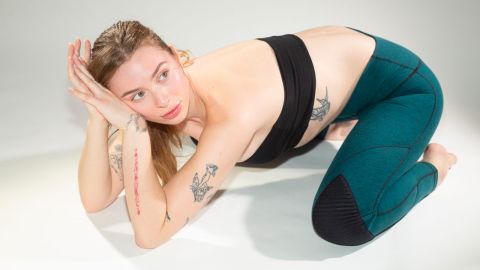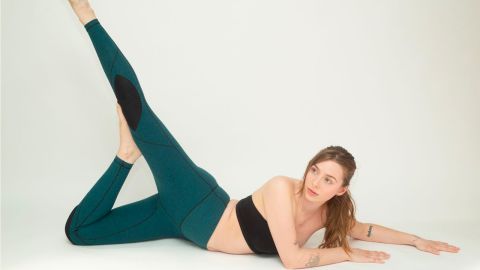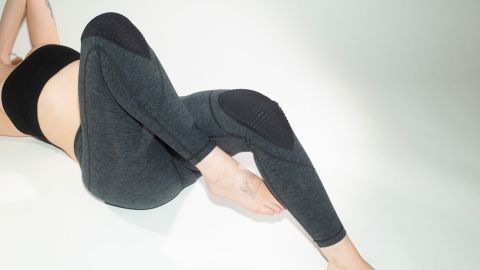[ad_1]
Between my frequent yoga habit and side hustle as a certified personal trainer with a specialization in orthopedic exercise, I spend an inordinate amount of time wearing, thinking about and writing about leggings. I thus couldn’t have been more excited to try out Maät’s leggings designed for practicing yoga without having to source any additional cushioning mid-flow.
While yoga is notoriously gentle on the joints — it’s fairly low-impact if you skip any jumping, and it advocates for deep, rhythmic breaths to facilitate movement — yoga without a mat can be painful and distracting. Grab a mat, and you should be fine, right? Not so fast. While a yoga mat has long been deemed an essential accessory to any successful yoga practice, research from the journal Phenomenology and Practice identifies the yoga mat as a barrier to entry for some folks in the way that it forces us to accumulate “more stuff” in the name of connecting with our bodies. “When it comes to a ‘serious’ practice,” writes author Gillian Lemermeyer, “the idea of the mat being necessary, even essential, persists.”
Like yoga mats, we’re constantly shifting the way we think about and use leggings (how many times is TikTok going to force me to buy the ones that scrunch up like an angry face at the butt?). What was once deemed an ‘80s aerobics essential has now become a wardrobe staple for casual and advanced yogis alike, making room for leggings to enter the market with unique features like built-in knee pads to replace that towel you need to keep on hand for your knees. That’s where Maät comes in.
The addition of a built-in knee pad is a brilliant way to make yoga more accessible to those suffering from pain or limited by the sheer space and weight of a yoga mat.
When Maät founder and designer Fiona Devaney noticed she needed to keep placing a towel under her knees during yoga poses to alleviate pain, she sought out a more time-efficient solution: leggings with built-in knee pads, inspired by the blissful built-in cushion she once experienced in a wetsuit while surfing. Born out of that discovery was the brand’s 1.0 Legging, which features a built-in moto-like tapered knee pad, and is designed with a soft yet durable material that offers slight compression and four-way stretch. They come in five versatile colors from army green to Metal for $148 a pop. Who are they for? Anyone who needs a little extra TLC at the knee region, or anyone practicing without a mat — either because they’re traveling or can’t be bothered to schlep it to the studio.

There’s lots to love about these leggings. Their compressive material and high-waisted fit offer a tucked-in feeling, which not only provides extra comfort, but reduces muscle fatigue, increases power output, and reduces joint and muscle strain. During wear-testing in a power yoga class, the seams felt secure during poses that require advanced range of motion at the hip flexors, like standing half-split, happy baby and bound bird of paradise. From a visual perspective, the knee pads are a far cry from something nerdy you’d strap on before rollerblading down a boardwalk. The curved seams surrounding the pads are intentionally designed to elongate the leg while offsetting any bulk.
The pads themselves, made of 100% foam covered by polyester and spandex, are nothing short of genius. When I practiced on both my hardwood floors and scratchy living room carpet, they provided a dreamy, pillowy-like sensation that enhanced my willingness to stay in knee-centric poses I resent, but know I should do more often, like cat-cow, camel and bird dog. While I, luckily, sorted out my patella issues in physical therapy a couple years ago, I can absolutely see how these leggings could support someone during their practice living with knee discomfort, be it degenerative or post-operative (under the supervision of their doctor or physical therapist, of course).
Along with power yoga, I tested these leggings during a Pure Barre class, which requires participants to spend an extended amount of time on all fours during movements like modified push-up and glute kickbacks. This places an inordinate amount of strain on the standing knee, which can detract from staying stable and engaged through the working leg. This time around, I felt like I could go on forever, all because my standing knee felt that much more supported atop the built-in knee pad.
For such a technical legging, I was surprised to see how simple they are to care for. Like any high-performance legging, they hold up best when hand-washed and line-dried, but they can also go in the machine on a cold, gentle cycle inside-out (just be sure to avoid folding them at the knee pad when storing so as to retain their shape).
While I appreciate the yoga-forward marketing, the brand sells itself short by pigeonholing itself into that narrow box. I can see these leggings serving as complete miracles for folks who spend lots of time doing housework, gardening or any other type of physical labor that requires transitional sit-to-stand movements. I kept the leggings on to scrub my bathroom, and let me tell you, my toilet has never been so clean.

As a short person at around 5 foot 3 inches, my knees are positioned quite lower than the average person’s, or at least lower than that of the prototype the brand used when designing these leggings. That means the built-in knee pads sit right at my shin bone below the knee, where I don’t necessarily need any padding during my workout. Due to this mismatch, I experienced a lot of bunching at the ankle, which not only caused slight discomfort and sensory overload, but limited ankle mobility and range of motion. Once I gathered the material at my thigh, I was able to experience the bliss of the knee pad. While the knee pad is not an eyesore by any means, you do feel its presence when walking or standing, making it — for me — more trouble than it’s worth.
While the brand was kind enough to send me two of their models — the charcoal and black leggings — I gravitated towards the charcoal for their slick, high-performance Tula fabric made of polyester and elastane, which is evocative of the Lululemon Wunder Train leggings I wear for everything from hot yoga to Peloton boot camps. The charcoal model provided more sweat-wicking properties than the black version, the brand’s original offering made of supplex and spandex that reminded me of the lounge-friendly Everlane 24/7 leggings that I reviewed last year (and promptly lived in). If you tend to sweat a lot, the material used in the black legging might not do the trick. Thankfully, because of its dark color, you won’t have to worry about any sweat stains.
The thing about a yoga mat is that it cushions virtually every facet of your body during your practice. What worries me about using these leggings solo — sans mat — is that the user is now lacking wrist support during poses like downward dog or chaturanga, or head support during shavasana or supine spinal twists. Your best option is to pair these leggings with a mat, or if that’s not feasible, some sort of travel-friendly microfiber towel to absorb sweat and additional impact.
Workout clothing — and specifically leggings — is an incredibly personal choice because our bodies are all shaped differently and we all move differently. The addition of a built-in knee pad is a brilliant way to make yoga more accessible to those suffering from pain or limited by the sheer space and weight of a yoga mat. While I had to finagle them to stay aligned with my knee, a taller person may find these leggings to be the difference between skipping a workout due to limitations or enthusiastically maintaining a yoga routine. At the very least, they make for a stellar gift for that one athletic friend who seems to have everything already, but can totally benefit from a functional wardrobe staple on, off — and maybe even without — the mat.
[ad_2]

